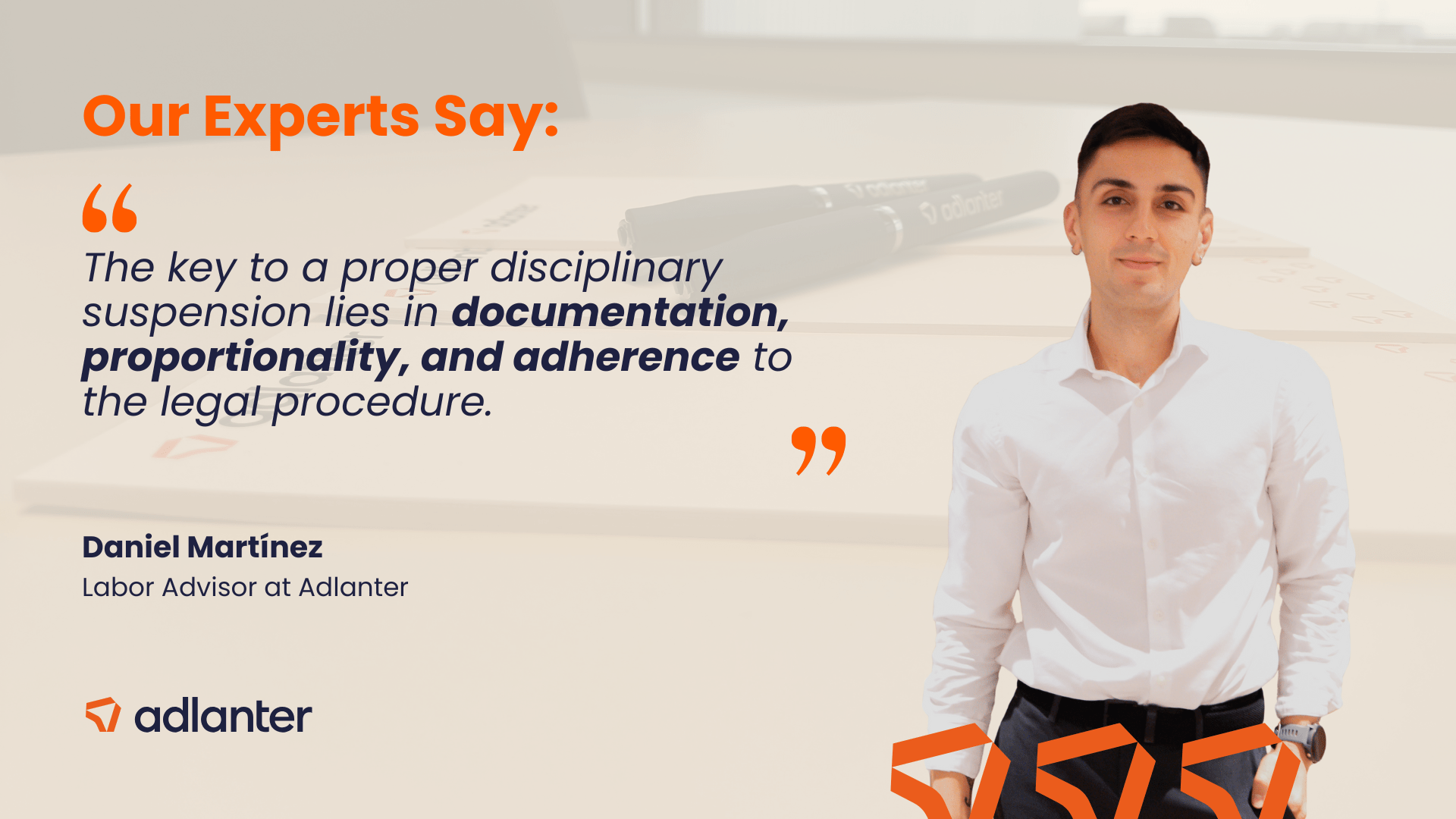Suspension of Employment and Pay in Spain: Practical Guide for Companies
This post explains the main characteristics of employment and pay suspension in Spain.
27/10/2025

📝- Index
- What is a suspension of employment and pay?
- Difference Between Disciplinary Suspension and Other Suspension Types
- Legal Grounds for Suspension of Employment and Pay
- Step-by-Step Legal Procedure
- Employee Rights During Suspension
- Obligations and Risks for the Company
- Practical Advice for Companies
- Frequently Asked Questions (FAQ)
- How Adlanter Can Help
Daily business operations can give rise to challenging situations where a suspension of employment and pay is considered. When is it legal? What rights does the employee have? How should a company act to avoid penalties?
In this post, our labor advisor Daniel Martínez explains everything you need to know, combining legal content with practical advice for companies.
What is a suspension of employment and pay?
A suspension of employment and pay is a disciplinary sanction that temporarily interrupts the main obligations of the employment contract: the employee’s provision of services and the company’s payment of wages.
It is crucial to understand that this is not a termination of the contract; the employment relationship remains active, but its principal effects are suspended during the sanction period.
Difference Between Disciplinary Suspension and Other Suspension Types
It is essential not to confuse disciplinary suspension with other legal figures that also interrupt the employment relationship:
-
Disciplinary suspension: a sanction imposed by the employer for a serious and culpable breach by the employee (as established in the Workers’ Statute).
-
Suspension for economic, technical, organizational, production, or force majeure reasons (ERTE): a collective or individual measure not of a disciplinary nature.
-
Suspension by mutual agreement: when the employee and employer agree to temporarily suspend the employment relationship.
This post focuses on disciplinary suspension, which generates the most questions for companies.
Legal Grounds for Suspension of Employment and Pay
Disciplinary suspension is regulated by the Workers’ Statute and collective agreements. It may only be applied in cases of serious or very serious offenses, such as:
-
Repeated and unjustified absences or lateness.
-
Indiscipline or disobedience at work.
-
Verbal or physical offenses.
-
Breach of contractual good faith or abuse of trust.
-
Continuous and voluntary reduction in performance.
Key note: The company must be able to prove the offense and apply the principle of proportionality, adjusting the sanction to the seriousness of the behavior.
Step-by-Step Legal Procedure
To ensure the sanction is valid, the company must follow a clear procedure:
-
Written notification: the employee must receive a communication detailing the facts, the date, the sanction, and its duration.
-
Prior hearing (in specific cases): if the employee is a legal representative or union delegate, a contradictory procedure must be opened in which the employee and the rest of the representatives are heard.
-
Compliance with limitation periods: the communication must occur immediately after the company becomes aware of the breach, following the time limits established by statute or collective agreement (minor offenses: 10 days; serious: 20 days; very serious: 60 days).
Employee Rights During Suspension
Even while suspended, the employee retains certain rights:
-
Validity of the contract: The employment contract remains in force, so the position is reserved.
-
No salary: The employee does not receive remuneration during the suspension period.
-
Social Security contributions: No salary payment means no contributions; the employee is considered in an “assimilated active” status without actual contributions.
-
Right to challenge: The employee may contest the sanction in labor court if deemed unfair or null.
Obligations and Risks for the Company
Incorrectly applying a suspension may lead to legal problems:
-
Judicial challenge: if a judge declares the sanction unfair or null, the company must pay the employee the lost wages and annul the sanction in the employment record.
-
Economic penalties: payment of wages and legal costs.
-
Reputational damage: internal conflicts and demotivated teams.
Practical Advice for Companies
To minimize risks and act correctly:
-
Document the offense: record incidents and objective evidence.
-
Check the collective agreement: it specifies offenses and maximum suspension periods.
-
Communicate clearly: avoid ambiguities in the suspension letter.
-
Meet legal deadlines: ensure timely delivery of the notification.
-
Consider alternatives: warnings, role changes, or corrective training may be prior solutions.
|

Frequently Asked Questions (FAQ)
How long can a suspension last?
It depends on the seriousness of the offense and the collective agreement, generally from a few days to several weeks. Minor offenses may be a few days, very serious offenses up to 60 days.
Are Social Security contributions made during the suspension?
No. During a disciplinary suspension, the employee is in an “assimilated active” status but does not make contributions because no salary is paid.
Can the employee be dismissed afterward?
Yes, if serious offenses accumulate and the legal procedure is followed, dismissal is possible.
What deadline does the employee have to appeal?
The employee has 20 business days from notification to challenge the sanction in labor court.
How Adlanter Can Help
At Adlanter, we assist companies in applying disciplinary and organizational measures legally and safely through our labor compliance service. We help you:
-
Analyze situations and determine if suspension is appropriate.
-
Draft legal and secure communications.
-
Implement clear and effective internal procedures.
For safe and professional application of disciplinary measures, contact us — we can guide you through every step.

Do you have any questions?
If you have any questions after reading "Suspension of Employment and Pay in Spain: Practical Guide for Companies", we are here to help you.
Let's talk. We guide you clearly and step by step.
